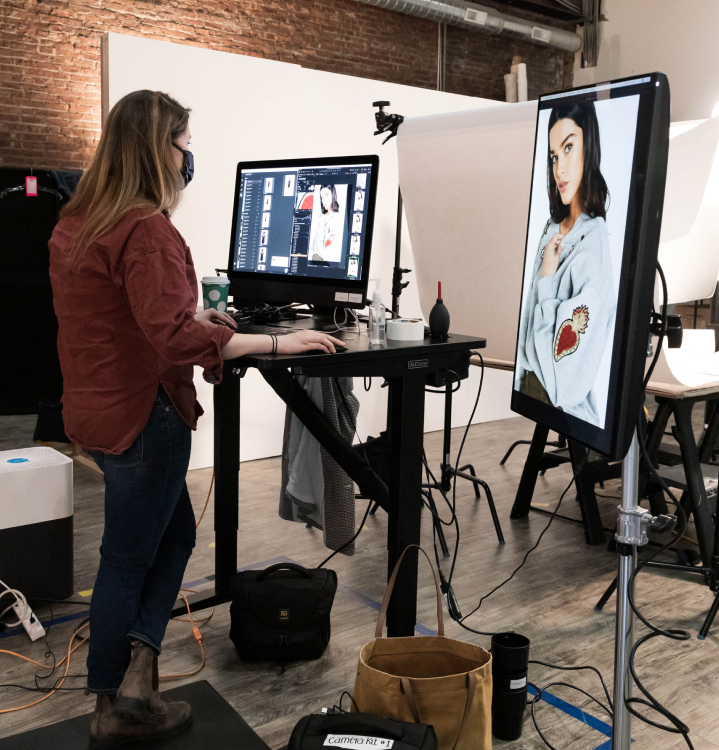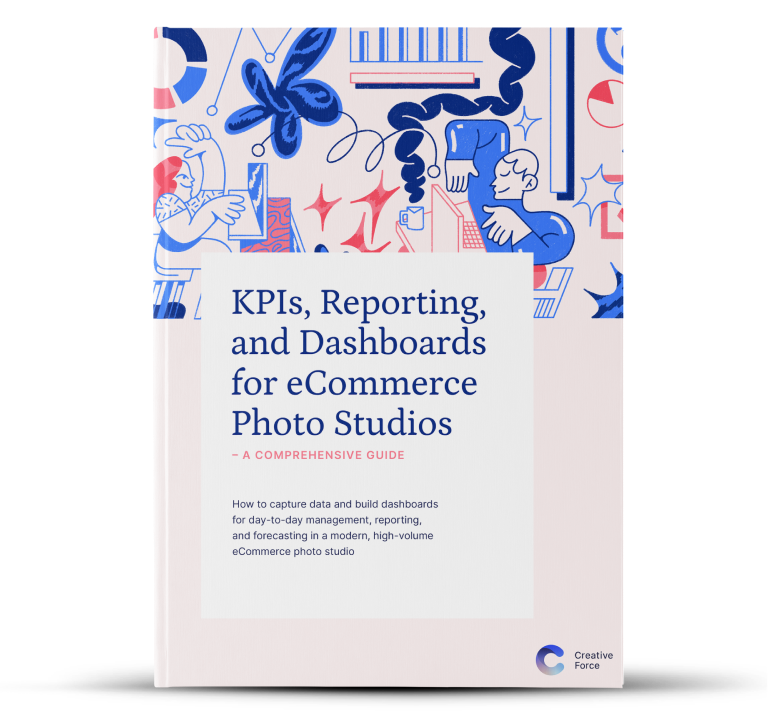Chapter 10
Customer & Stakeholder Relationship Reporting
Nearly everyone has at least one email that they receive every week (or every day) asking for the same production information. This email is often the bane of your existence, and either requires manual reporting to answer, or else it just requires you to peek into your studio management tools to report back. Let's look at why we tend to get this type of email.
Photo studios can feel like a bit of a blind spot to their partners, stakeholders and customers. There's often quite simply a giant gap between what people think goes on in a photo studio and what actually goes on. Anyone who's tried to explain their studio job to someone outside of the studio has probably experienced this, as they explain for the 100th time that, no, they are not a photographer. And while some studios are protective and like to keep this mystique about their processes, it's really bad for everyone involved. People have to understand what you do in order to understand your value. Likewise, a larger organization (or if you're a commercial studio, your customer) needs to understand the value you bring. Especially if you want that raise, those new hires, or that budget approval for shiny new tools.
Introduction to Studio Reporting and KPIs
Setting the Right Goals, the Right Way - Making Use of Your KPIs
Systems & Data
Introduction to Reporting
Reporting For Higher Management
Daily Production Monitoring
Team & Talent Performance
Post Production Vendor Management
Flow Reporting
Customer & Stakeholder Relationship Reporting
Financial Reporting
Styling & Inventory
Asset Performance & Conversion Reporting
Visual Reports
Advanced Reporting in Looker
Stakeholder Reporting: Give the People What They Want, When They Want It
This is where customer and stakeholder reporting comes into play. The common theme of this style of reporting is making it easier for people outside of your studio and your tools to get information. For leadership, this might take a little packaging, and you might want to show high-level things like overall studio health, output, and budget. You can read more about reporting for management here. But what about coworkers, stakeholders and customers? They'll need more tactical reports. They'll want to know things like specific statuses, sample availability, ETAs, red flags, and things that affect their side of the business.

Here are some examples of reports stakeholders may want:

SLA Turnaround Times
If you have an SLA with your organization that promises a specific turnaround time, you should have a report measuring it that you can share. You gotta take time to show off what you're doing right!

High Level Status Reports
Being able to show an at-a-glance status of where you stand in a specific season, year, quarter, or large shoot is a great way to build trust and cut down on ad-hoc questions. For example, "we're 78% done shooting the Winter season and we're 94% done shooting items we've received a sample for."

At Risk Items
I'm a big proponent of having an at-risk "hot sheet" report that is delivered to all stakeholders weekly. It informs others, gives them time to escalate, and it takes the studio out of "chasing" things. Having everybody looped into "at-risk" reporting makes things more collaborative and makes the studio less likely to be blamed for things out of their control.

Sample Auto-Updates
Sample availability is one of the main reasons things don't get online when they need to be. It's also one of the most frustrating and unpredictable aspects of a studio. Rather than having people constantly asking about samples, or wondering why you haven't shot the sample that arrived 30 seconds ago, make stakeholders a regular part of sample updates

Deadline Success Rate
We often, and this applies to life outside the studio as well, focus too much on what we get wrong and not enough on what we get right. I'm sure this serves humans some evolutionary purpose, but it's also a bummer. A studio will always get an email when a product misses a deadline, but you won't get an email pointing out that you hit your deadlines 99.3% of the time. This is important for people like your CMO to know!

Self Serve Reporting
This one could have a whole chapter about it. In general, this just means being proactive about your partner’s needs. If marketing is always chasing your samples to borrow, why not make your sample tracking available to them as well? If merch always wants to know what was shot this week, why not publish a list of everything that was shot each week? Serve up the info so people who need answers can find what they need. And you can focus on your studio work.
Getting Ahead of "The Email"
So, obviously some transparency is needed. Not only do people need to understand what you do, and the value you provide, but they also need to be able to access this sort of information easily. And preferably not have to chase it down. This brings me to what I call "the email."
- 1.What is the status of [xxxxxx] product? When will it be available?
- 2.What's our cost per shot?
- 3.When are we shooting [xxxxxx]?
- 4.Did you receive [xxxxxx] yet?
- 5.Have we received a sample for [xxxxxx] yet?
It's easy to be annoyed by these inquiries, but it's not the sender's fault. They need info to do their jobs! And information is already siloed in most companies, before even taking into account the specialized tools that studios use. These tolls often have steep learning curves or paid user seats not available to others. So how can we make this easier for everyone? We have to free the data and make it available to all. But how do we do that?
Well, the short answer is to unlock your data. Let people in! If someone needs a user seat, even if it's read-only, so they can see what samples are missing, get them a user seat! If you can schedule a report to a stakeholder weekly, or daily, you cut out the need for emailing back and forth. These things are incredibly helpful for keeping your team in the studio on-task and not always reacting to the latest question. They're also great trust-builders with stakeholders and overall great way to knock down some siloes
Still, the more honest answer is that this all requires some relationship building. All that talk about people needing to understand what the studio does? It goes both ways! You need to meet with your stakeholders regularly, talk to your customers, and truly understand what they do (and how your studio fits into their needs). Perhaps you were delivering everything 5 days ahead of the deadline, but you were unaware that the copy team needed 7 days to complete a product's copy. You'll never know if you stay hiding out in the studio. Invite people to the studio, go meet with them at HQ, and get to know who's on the other side of "the email." And most importantly, learn what they need and provide it - preferably automated deliveries or customized dashboards that they care about.
So what would these stakeholders care about? Well, as we said, you have to talk to them. But here are a couple examples, based on my own experience.
Do
- Talk to your stakeholders and learn their needs
- Automate reports that service these stakeholders
- Meet regularly to check in
Don't
- Assume you know what stakeholders need
- Be protective about data or systems the studio uses
- Think that sending reports replaces regular check ins and relationships
Deadline Success Rate (SLA)
![]()
Leadership Goal/s
Reducing time to market; Improving Operational Efficiency
![]()
Studio Goal/s
Deliver 99% of priority products on-time and 95% of all products on-time in Fall/Winter 2023.
![]()
KPI
Percentage of products delivered on-time
![]()
Data Sources
Product Code, Status, Due Date, Asset Delivery Date, Department (or Requestor)
![]()
Dimensions
Product Code, Status, Due Date, Asset Delivery Date, Department (or Requestor)
![]()
Metrics
Count of Products Delivered On-Time
![]()
Report Type
Numeric (percentage)
Measuring Your Deadlines and SLA's - for Specific Partners
This is a spinoff report to one we discussed previously, the On-Time Success Rate report. While that report looks at overall performance, a quick filter or adjustment for your customers or stakeholders makes this report all about them. Your goal will be the same, to show what percentage of products had their imagery delivered on-time, but you'll cater this report to a partner. If you have multiple merchants, or departments requesting imagery from your studio, filter the report on those requestors, and then report out back to them. If you are a commercial studio, this could be various clients or customers.
The point here is that you are taking something that you need to report internally anyways (your success rate at delivering imagery on time), and you are turning it into a tool to show your partners that you care about their success. Proactively reaching out to partners and reporting on your studio's success in delivering imagery for THEIR products is a great step toward transparency and trust-building across functional teams and departments. Assuming you're doing a good job, which most studios are, it is also a good opportunity to remind partners of the 98% of products you deliver on (and not the 2% that get all the attention!).
With regards to deadlines, for some studios like a brand or wholesaler, your deadline may be something like a live date, or a specific set of dates that imagery needs to be ready to sell products online. For retailers or DTC brands, moving in a faster-paced, or season-agnostic world, your deadline might be more of an SLA turnaround time (example: "7 days from sample check-in at the studio"). Whatever the business logic, you should have a deadline for all products and samples that come through your studio, and you should know who your “customer” is internally. And better yet, you should report out to that customer regularly on the products they care about.
Setting up a report like this one should be relatively simple, and many pieces of software can probably do it automatically for you. In your column A, you'll want a Product Code. In column B, you'll want a status ("complete" or "in progress"). Column C will be your Due Date, or Live Date (whatever your deadline is). And column D will be the date of completion (blank if it is not yet complete). You can calculator this a few different ways; I prefer to make one additional column E that calculates whether the product's images were on time (a product is late if the delivery date is greater than the due date - or if the delivery date is blank and the due date is earlier than today's date). If you've already built this report from the chapter on Reporting For Higher Management, simply add a filter for "requestor," "customer," or "department" - basically an indicator of whomever you would like this report to be for.


Take It a Step Further!
- Compare and contrast! Compare your success rates across various customers, stakeholders, or partners. Dig into why success rates may be higher in some areas and lower in others.
- Get that context! If you are seeing this KPI dip for some stakeholders, you'll need to dig into your data to find out why. Were samples delivered on time? Check a cycle time report - did the imagery get stuck somewhere along the way? One of the great things about building a suite of robust reports is that when one report calls something to your attention, but requires more context, chances are you already have another report built that can provide that context.
Added Value Report (Example: Additional Shots)
![]()
Leadership Goal/s
Create Better Content; Improve Operational Efficiency
![]()
Studio Goal/s
Add an additional angle to all womens denim on a flat budget
![]()
KPI
Percentage of women's denim receiving 3 alts (instead of 2) in Fall/Winter 2023
![]()
Data Sources
Studio management platform; Asset Tracking & DAM
![]()
Dimensions
Product Code, Department, Category, Status, Season
![]()
Metrics
Count of Associated Assets
![]()
Report Type
Numeric (percentage)
Creating Better Content, Creating More Content, and Looking Good Doing It
The Added Value report is an awesome one because it supports an under-represented goal of creative organizations: Creating Better Content. The word "better" can seem ambiguous, and that's where added value comes in. It's pretty universally accepted that additional angles, detail shots, and especially video all increase sales on PDP pages. There are exceptions, and of course a point of diminishing returns. But for most studios, it would be considered a definite win if you are able to increase creative output, adding angles and detail shots, potentially even adding product videos, all while on a flat budget. I've seen this happen first hand and it's a great feeling of accomplishment. It's also difficult to measure, which is where an Added Value report comes in.
Let's start off a hypothetical studio and some hypothetical financials - these will help demonstrate concrete ways to report on added value.
- 1.In-house studio for a denim brand
- 2.$2m/annual budget
- 3.10,000 products yearly (50% mens, 50% womens)
- 4.4 angles shot per product (front, side, back, detail)
- 5.Based on above, cost per shot is $50
Let's use this example studio as a jump-off point. They are currently shooting the basics: front, side, back, detail. A great move in a situation like this would be to offer your teams a challenge: continue to hit the numbers each day, but let's add in one "lifestyle" shot, with more fluid posing, to all womens products (50% of the line, or 5,000 products). Photographers love this direction and models absolutely do as well. The energy stays higher on set, people get to be creative, and things still move quickly (sometimes faster, since people aren't in their "front, side, back" rut!). It's simply not that far-fetched to target one additional angle of shooting once you have a model dressed, styled and on set.
Assuming our hypothetical studio was able to successfully add that one angle to womens denim, the annual added value is in the $200k - $250k range, depending on exactly how you calculate it (5000 I view this KPI/report as best being two numbers side by side: one, the percentage of products you managed to produce an additional angle for, and two, the dollar amount of value added.
There are additional ways to make this even more interesting, like incorporating conversion rates for example. After all, additional angles don't mean much if they don't convert. All things considered, I'm comfortable saying this: if your studio can produce more editorial style content, more quickly, at the same price? People are going to be very pleased about that.

Take It a Step Further!
- See what works! Partner with your web team to track conversion rates. If possible, run A/B tests on products: some with your additional angles, others without. If you are able to attach actual sales numbers to your efforts, the value add will be even more concrete and undeniable.
- Create what people want! Use this as an opportunity to offer your team - or your stakeholders - a chance to pitch value adds. Perhaps your email marketing team always needs custom GIFs to use. Perhaps your stylist wants to spend extra time shooting capsules. Perhaps a photographer on the team is interested in learning video. Perhaps the social team wants BTS shots. Find out what people want, and then set about layering it onto your process as efficiently as possible.

Want the eBook?
Our comprehensive guide to KPIs, Reporting, and Dashboards is available as an eBook.
Sign up now and we'll send you a copy to your email.
Want the eBook?
Sign up now and we'll send you a copy as soon as it's released.